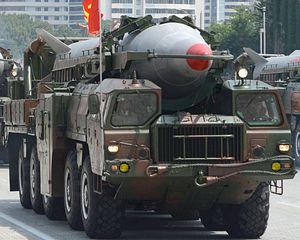North Korea launched three Nodong-1(A) nuclear-capable medium-range ballistic missiles from a testing site near Hwangju, North Hwanghae Province, around 12:14 pm local time on September 5, according to Yonhap News Agency. The launch was first reported by the Joint Chief of Staff of Republic of Korea (JCSROK).
“The three missiles all flew about 1,000 km and landed in waters some 400 km inside Japan’s air defense identification zone in the East Sea,” a JCS official told reporters. He added that North Korea failed to inform Seoul in advance of the missile test. The test-firing of the missiles was broadcasted by state-owned Korean Central Television (KCTV).
Despite media reports, it is still unclear what type of missile North Korea tested on September 5.
The U.S. Strategic Command confirmed the tests, but noted that it was unsure whether the three missiles were indeed Nodong medium-range ballistic missiles. The missiles seen in the broadcast could also be the longer-range Nodong-B (aka BM25 Musudan or KN-07) missile or another Scud variant. The Nodong-1 missile has a maximum range of 1,300-1,500 kilometers, whereas the range of the intermediate-range Nodong-B is estimated at 2,500-4,000 kilometers.(The website Arms Control Wonk has a good summary to how the United States names North Korean missiles.)
“U.S. Strategic Command (USSTRATCOM) systems detected and tracked what we assess were three North Korean missile launches at 10:13 p.m. CDT, September 4, 2016, near the western city of Hwangju. Two of the three missiles are presumed to be intermediate-range ballistic missiles. The type of the other missile is still being assessed. The missiles were tracked over North Korea and into the Sea of Japan.”
The footage of the launches shows that the missiles were launched from Transporter Erector Launchers (TEL) in rapid succession. In 2016, previous test launches of the Nodong-1 missile occurred in March, July, and August. The Nodong-B missile was last tested in June. While North Korea announced that the June test-launch was a success, South Korean and U.S. analysts were skeptical.
KCTV claimed that North Korean dictator Kim Jon Un provided “field guidance to the fire drill” conducted by the “Hwasong artillery units of the KPA [Korean People’s Army] Strategic Force.” According to KCTV, “those units are tasked to strike the bases of the U.S. imperialist aggressor forces in the Pacific operational theater in a contingency.”
The North Korean dictator purportedly congratulated the missile crews and expressed his satisfaction with the test launches. Next to Kim Jon Un, the drill “was observed by senior officials of the Central Committee of the Workers’ Party of Korea including Ri Man Gon, Ri Pyong Chol and Kim Jong Sik and officials in the field of national defense science research,” KCTV reports.
Analysts believe that the test is meant to show off its missile capabilities to the leaders of the G-20, who held a summit in Hangzhou, China from September 4 to September 5. The missiles launches are also interpreted as show of force in the face of the deployment of an of an advanced U.S. missile defense system on the Korean peninsula, the so-called the Terminal High Altitude Area Defense (THAAD) system.
“The United States strongly condemns North Korea’s launch of three ballistic missiles,” U.S. State Department spokesman John Kirby said in a statement. “These launches, which have become far too common in the past several months, violate multiple U.N. Security Council Resolutions explicitly prohibiting North Korea’s launches using ballistic missile technology.”

































